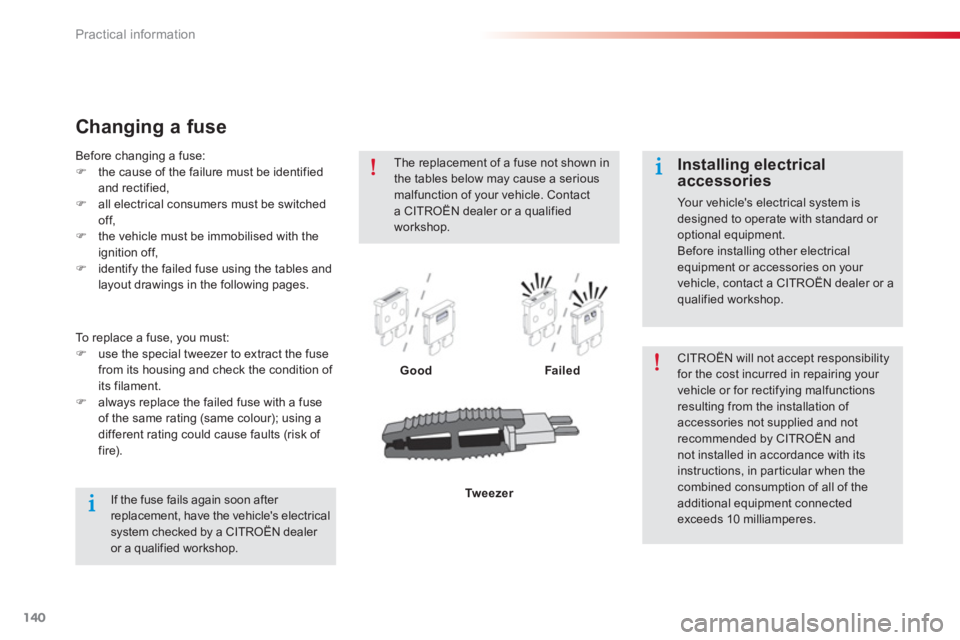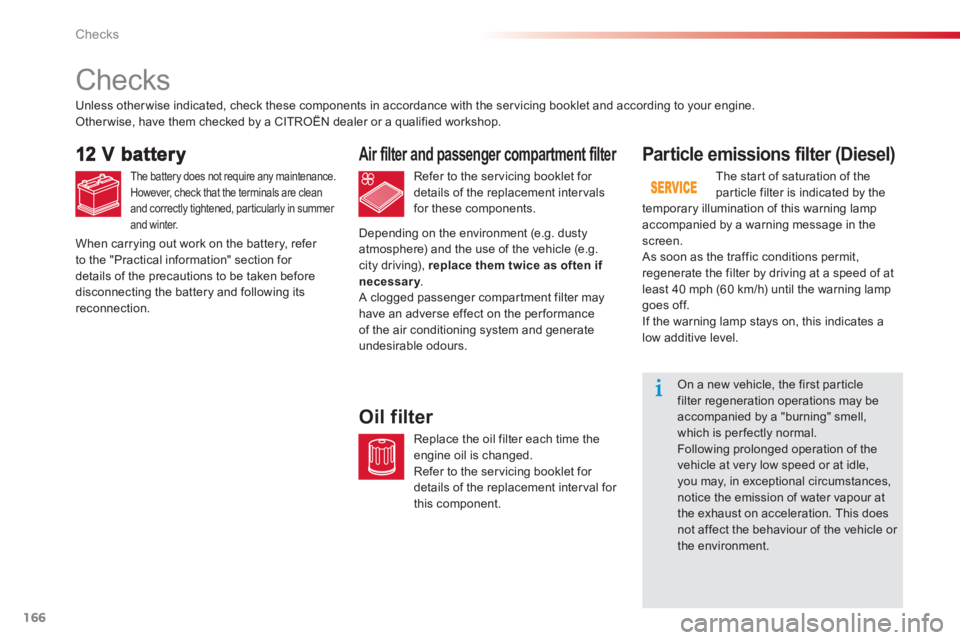follow me CITROEN C-ELYSÉE 2014 Handbook (in English)
[x] Cancel search | Manufacturer: CITROEN, Model Year: 2014, Model line: C-ELYSÉE, Model: CITROEN C-ELYSÉE 2014Pages: 257, PDF Size: 9.06 MB
Page 111 of 257

109
7
Safety
Sit in a normal upright position. Wear a correctly adjusted seat belt.
Do not leave anything between theoccupants and the airbags (a child, pet, object...). This could hamper the operation of the airbags or injure the occupants. After an accident or if the vehicle has beenstolen or broken into, have the airbagsystems checked. All work on the airbag system must be carried out by a CITROËN dealer or a qualified workshop.
Even if all of the precautions mentionedare obser ved, a risk of injury or of minor burns to the head, chest or arms when an airbag is deployed cannot be ruled out. Thebag inflates almost instantly (within a fewmilliseconds) then deflates within the same
time discharging the hot gas via openings provided for this purpose.
Lateral airbags
Use only approved covers on the seats, compatible with the deployment the lateralairbags. For information on the range of seatcovers suitable for your vehicle, you can contact a CITROËN dealer. Refer to the "Accessories" section.Do not fix or attach anything to the seatbacks (clothing...). This could cause injuryto the chest or arms if the lateral airbag isdeployed.Do not sit with the upper par t of the body anynearer to the door than necessary.
Front airbags
Do not drive holding the steering wheel by itsspokes or resting your hands on the centre part of the wheel.
Passengers must not place their feet on thedashboard.
If possible, do not smoke as deployment of the airbags can cause burns or the risk of injury from a cigarette or pipe.
Never remove or pierce the steering wheel or hit it violently.
For the airbags to be fully effective, observe the following safety rules:
Page 112 of 257

110
Child safety
General points relating to child seats
For maximum safety, please obser ve the following recommendations:
- in accordance with European regulations,
all children under the age of 12 or less
than one and a half metres tall must
travel in a
pproved child seats suited to
their weight , on seats fitted with a seat
belt or ISOFIX mountings * ,-statistically, the safest seats in your
vehicle for carrying children are the rear seats,- a child weighing less than 9 kg must
travel in the "rearwards-facing" position both in the front and in the rear.
CITROËN recommends that childrenshould travel in the rear seats
of your vehicle: - "rearwards-facing"up to the age of 2, -
"forwards-facing"
over the age of 2.
Although one of CITROËN's main criteria when designing your vehicle, the safety of your childrenalso depends on you.
*
The rules for carrying children are specific to each country. Refer to the current legislation
in
your country.
Page 119 of 257

117
8
Child safety
ISOFIX child seat recommended by CITROËN and approved for
your vehicle
This child seat can also be used on seats which are not fitted with ISOFIX mountings.
In this case, it must be attached to the vehicle seat using the three point seat belt. Follow the instructions for fitting the child seat given in the seat manufacturer's installation guide.
RÖMER BabySafe Plus ISOFIX(size category E)
Group 0+: up to 13 kg
It is installed in the rear ward facing position using an ISOFIX base whichattaches to the rings A
.
The stay for the ISOFIX base must be adjusted in height so that it iscontact with the floor of the vehicle.
RÖMER Duo Plus ISOFIX(size class B1)
Group 1: from 9 to 18 kg
It is installed in the for wards facing position. It is fitted with an upper strap that is attached to the ISOFIX upper ring,called the TOP TETHER.
Three angles for the shell: sitting, inclined and lying positions.
Page 142 of 257

140
Practical information
Changing a fuse
GoodFailed CITROËN will not accept responsibilityfor the cost incurred in repairing your vehicle or for rectifying malfunctions resulting from the installation of accessories not supplied and not
recommended by CITROËN andnot installed in accordance with its instructions, in par ticular when thecombined consumption of all of the additional equipment connectedexceeds 10 milliamperes.
Installing electricalaccessories
Your vehicle's electrical system isdesigned to operate with standard or optional equipment.
Before installing other electrical equipment or accessories on your vehicle, contact a CITROËN dealer or aqualified workshop. Be
fore changing a fuse:
�)the cause of the failure must be identifiedand rectified, �)all electrical consumers must be switched
off,
�)the vehicle must be immobilised with theignition off,�)identify the failed fuse using the tables andlayout drawings in the following pages.
To replace a fuse,
you must: �)use the special tweezer to extract the fuse
from its housing and check the condition of its filament.�)always replace the failed fuse with a fuse
of the same rating (same colour); using a
different rating could cause faults (risk of fire).
Tweezer
The replacement of a fuse not shown in the tables below may cause a serious malfunction of your vehicle. Contacta CITROËN dealer or a qualified workshop.
If the fuse fails again soon after replacement, have the vehicle's electricalsystem checked by a CITROËN dealer or a qualified workshop.
Page 147 of 257

145
9
Practical information
Starting using another
battery
�)Connect the red cable to the positive
terminal (+) of the flat battery A , then to the positive terminal (+) of the slave battery B .�)Connect one end of the green or blackcable to the negative terminal (-) of the slave battery B.
�)
Connect the other end of the green or blackcable to the ear th point C
on your vehicle (engine mounting).�)
Operate the star ter, let the engine run.�)
Wait until the engine returns to idle and disconnect the cables.
Charging the battery using
a battery charger
�)
Disconnect the battery from the vehicle.�)
Follow the instructions for use provided by
the manufacturer of the charger. �) Connect the battery starting with the
negative terminal (-).�)
Check that the terminals and connectors
are clean. If they are covered with sulphate (whitish or greenish deposit), remove themand clean them.
Page 151 of 257

149
9
Practical information
Towing the vehicle
Access to the tools
The towing eye is installed in the boot under
the floor.
To gain access to it: �)open the boot, �)lift the floor and remove it,
�)remove the towing eye from the holder.
General recommendations
Obser ve the legislation in force in your country. Ensure that the weight of the towing vehicle is higher than that of the towed vehicle. The driver must stay at the wheel of the towed vehicle.Driving on motorways and fast roads is prohibited when towing.When towing a vehicle with all four wheels on the ground, always use an approved towingbar; rope and straps are prohibited. When towing a vehicle with the engine off, there is no longer any power assistance for braking or steering.
In the following cases, you must always call on a professional recovery service: - vehicle broken down on a motor way or fast road, - when it is not possible to put the gearbox into neutral, unlock the steering, or release theparking brake, - towing with only two wheels on the ground, - where there is no approved towing bar available...
Procedure
for having your vehicle towed using the towing eye, removable at the front, fixed at the rear.
Page 152 of 257

150
Practical information
To w i ng your vehicle
To w i ng another vehicle
�)On the front bumper, unclip the cover by pressing on the left edge. �)Screw the towing eye in fully. �)Install the towing bar.
Put the gear lever into neutral (position N
for an electronic or automatic gearbox). Failure to follow this instruction maycause damage to some components(braking, transmission...) and the absence of braking assistance when the engine is restar ted.
�)
Unlock the steering by turning the key
in the ignition one notch and release the
parkin
g brake.�) Switch on the hazard warning lamps onboth vehicles. �)
Move off gently, drive slowly and for a shor tdistance.
This towing is strictly prohibited (risk of damaging your vehicle).
Page 168 of 257

166
Checks
Checks
The battery does not require any maintenance.
However, check that the terminals are clean
and correctl
y tightened, particularly in summer and winter.
Par ticle emissions filter (Diesel)
The start of saturation of thepar ticle filter is indicated by the
temporary illumination of this warning lamp
accompanied by a warning message in the screen.
As soon as the traffic conditions permit,
regenerate the filter by driving at a speed of at
least 40 mph (60 km/h) until the warning lampgoes off.
If the warning lamp stays on, this indicates a
low additive level.
On a new vehicle, the first particlefilter regeneration operations may be accompanied by a "burning" smell,
which is perfectly normal.
Following prolonged operation of the vehicle at very low speed or at idle, you may, in exceptional circumstances,notice the emission of water vapour at the exhaust on acceleration. This does not affect the behaviour of the vehicle or the environment. Unless other wise indicated, check these components in accordance with the ser vicin
g booklet and according to your engine.
Other wise, have them checked by a CITROËN dealer or a qualified workshop.
Air filter and passenger compartment filter
Refer to the servicing booklet for
details of the replacement inter vals
for these components.
Oil filter
Replace the oil filter each time theengine oil is changed.
Refer to the ser vicing booklet for
details of the replacement inter val for
this component. When carr
ying out work on the battery, refer
to the "Practical information" section for
details of the precautions to be taken before
disconnecting the battery and following itsreconnection. Dependin
g on the environment (e.g. dusty
atmosphere) and the use of the vehicle (e.g.city driving), replace them twice as often if necessary.y A clogged passenger compar tment filter may
have an adverse effect on the performance
of the air conditioning system and generateundesirable odours.
Page 175 of 257

173
11
Technical data
Identifi cation markings
A.Vehicle identification number (VIN)under the bonnet.
This number is engraved on the bodyworknear the passenger compartment filter.
The tyre pressures must be checked when the tyres are cold, at least oncea month.
Low tyre pressures introduces the riskof a burst tyre and also increase fuel consumption.
B.Vehicle identification number on thedashboard. This number is indicated on a self-adhesive label which is visible through the
windscreen.
C.Manufacturer's label.The VIN is indicated on a self-destroying
label affixed to the lower right hand centre
pillar.
D.Tyre/paint label.This label is affixed to the driver's side centre pillar. It bears the
following information:
- the tyre pressures, for unladen and laden
conditions,
- the tyre sizes,
- the spare t
yre inflation pressure,
- the paint colour code.
Various visible markin
gs for the identification of your vehicle.
Page 187 of 257

185
04
Select a line in the list.
Select a track or a folder.
Skip a track.
Up a level in the menu.
AUDIO
USB MEMORY STICK - FILE
CLASSIFICATION
Having selected the desired classifi cation (" By folders", " By artists", " By genres", " Byplaylists
") press the control knob.
Then press the control knob to con
fi rm andsave the modifi cations.
-By folders: all folders containing audiofi les recognised on the peripheral device, in alphabetical order without following the folder structure.
-
By artists
: all of the artist names defi ned in the ID3 Tags, in alphabetical order.
-
By genres
: all of the genres defi ned in the ID3 Tags.
-By playlists
: if playlists have been saved.
Make a long press on LISTor press
MENU , select " Multimedia
", then
" Media parameters" and fi nally "Choice of track listing
" to display the differentclassifi cations.